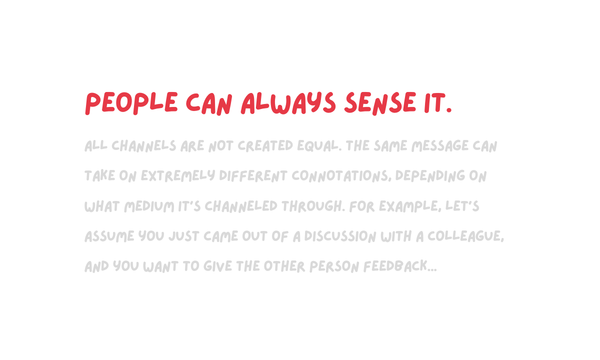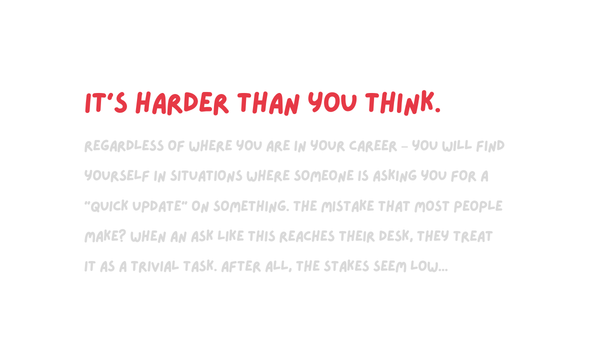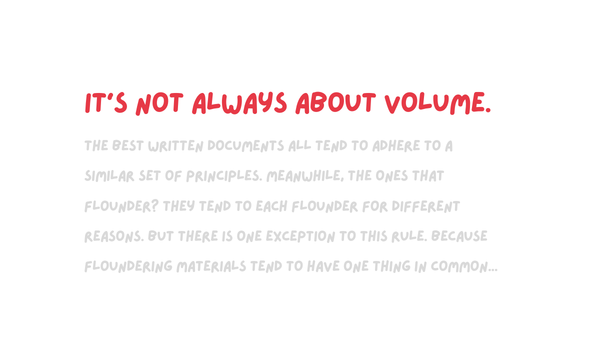How to Write in a "Polished" Manner at Work
...9 tips to help earn your reader's attention.
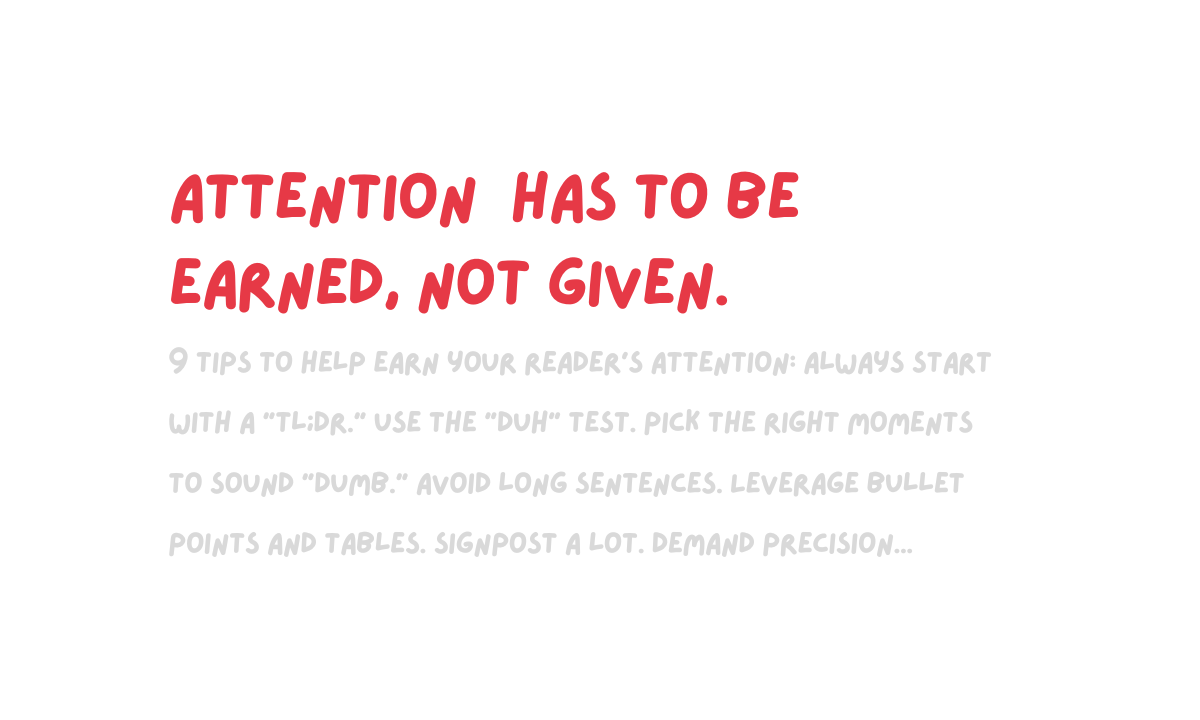
In this week's newsletter, we'll talk about how to write at work so your written comms can come off as highly "polished."
(There's no secret formula. You just need to apply certain principles.)
- Always start with a "tl;dr."
- Use the "duh" test.
- Pick the right moments to sound "dumb."
- Avoid long sentences.
- Leverage bullet points and tables.
- Signpost. A lot.
- Demand precision.
- Lead with the beef.
- Write with an audience in mind.
👋 Join 4900+ readers and subscribe to Herng's Newsletter for free:
Most people engage in 3 types of writing at work:
- Emails
- Slides
- Documents
Our focus today is on documents, i.e. content that is primarily based on prose.
For best practices on the other two: see my take on how to build exec-ready slides and how to write effective emails.
What is "polished" writing?
One thing is worth establishing up front: Polishedness is a result of writing in a highly effective manner. And polishing can help us get there. It is the process – not the goal.
Therefore, before talking about how to polish our written comms, let's first establish what polished writing tends to achieve. In general, we are chasing 3 key outcomes:
- Ensure the reader comprehends the content easily
- Minimize risk of misinterpretation or confusion
- Establish credibility and persuade effectively
It's worth noting that the first two outcomes should be seen as non-negotiable. Any piece of writing can (and should) be polished to achieve those two outcomes.
(The third one, however, is a bit more dependent on the inherent quality of your content. After all, you can only put so much lipstick on a pig.)
While there is no single "right" way of polishing our written comms, there are quite a few best practices that can help get the job done.
Here are 9 (relatively low-lift) ones I recommend adopting:
#1 Always start with a "tl;dr."
"tl;dr" = "too long; didn't read." It's a quick summary (usually no more than 2-3 sentences) that should preface any document (or lengthy email).
For example:

There's 3 reasons why leading with a tl;dr section is critical, even if you think what you've written is crystal clear already:
- Think of it as insurance. Few people read a document from end to end; most people simply scan. Your tl;dr section, therefore, can help minimize the risk of misinterpretation. You ensure that your key takeaways will always register with your reader.
- It's a great forcing mechanism. You're forced to distill your key message down to 2-3 sentences. In fact, I often try to establish my tl;dr first, before jumping into any actual writing. It ensures that whatever I end up writing actually contributes to my key thesis.
- It helps you identify superfluous content. When you write your tl;dr, you're implicitly determining what are the most important messages – and what aren't. This allows you to then identify (and drop) less-relevant content. When people praise a document or presentation for being "tight" – that is what they mean.
👋 Subscribe for free to get Herng's newsletter directly in your inbox.
#2 Use the "duh" test.
The "duh" test is this: you read what you write, and you ask yourself:
- Would anybody read this and go "duh!" (or "no sh*t")?
If you've written something that no one would realistically disagree with – it's a waste of space (and your reader's time). Every occurrence simply becomes another cue for your reader to dismiss that paragraph and skip ahead.
Here are a couple real-life examples I've seen that fail the "duh" test:
"This project was enabled by collaboration and deep alignment..."
Who would ever argue that collaboration isn’t important for any project? And what new insight about collaboration have you identified?
Here's another example:
"Our focus and attention will be centered on our org’s themes..."
First off, don’t focus and attention mean the same thing? Also, who would realistically claim that their strategy doesn’t align to their organization’s focus areas? This fails to say anything of importance.
If anything, I’d be more interested in reading a paragraph that starts with “we’re focusing on something very different from other teams.”
There's obviously a caveat here: something that's patently obvious to me might be eye-opening for you. And vice versa. This is why knowing your audience matters (we'll cover this later).
Otherwise – the "duh" test can help tighten up your writing immensely.
#3 Pick the right moments to sound "dumb."
We're not really trying to sound "dumb," of course. But you'll find that in an attempt to sound professional or smart – most people end up littering their writing with generic corp-speak.
And they forget that they need to storytell.
Consider the following paragraph:
Wakanda is a fast-growing market with significant potential. We are currently under-monetized (compared to mature-market benchmarks), and we have an opportunity to achieve profitable ROI if we can prioritize Wakanda for our new feature launch this year.
OK, this paragraph isn't bad at all. It's factual and professional.
Consider instead, however, what we could achieve if we led with the following statement instead:
We're leaving a lot of money on the table in Wakanda. Here's how we can capture it...
Let's be clear: sounding "dumb" doesn't mean you water everything down. It doesn't give you the right to ignore numbers or engage in generic platitudes either.
Rather, it means that you find the simplest way to anchor or hook your audience. Then you have permission (and the obligation) to back it up with rigorous detail.
For example, consider the following paragraph:
Our DAUs have been trending down for 3 quarters. Despite doubling our marketing spend this quarter, we have yet to see a statistically significant increase in new users acquired. We should explore external partnership opportunities and redesign our user incentives program instead.
Fair, factual, objective...yet it feels like something's missing. How about:
We're losing users. And doubling down on marketing isn't quite working. Here's our proposed fix...
Again, you're not trying to "dumb down" your entire body of content. That would be foolish. But you are trying to tell your audience how to feel right off the bat. And if you can do that crisply – you have their attention.
(Which then gives you the license to pitch further detail and nuance.)
Think of the act of "dumbing it down" as cooking with spices: too much or none at all results in a failed dish. But doing it selectively at the right moments? It adds a powerful kick to your end product.
👋 Subscribe for free to get Herng's newsletter directly in your inbox.
#4 Avoid long sentences.
I can't think of many instances where long sentences work better than short ones. It simply adds more tax for the reader.
But what if your content has to be nuanced? What if it's too complex to be shortened? What if there are critical caveats that cannot be omitted?
I call BS on that. That's a false dilemma. There's always a way to simplify. Because you can always...
#5 Leverage bullet points and tables.
The most readable documents I see at work aren't constrained by prose. Their authors leverage a mix of formats to convey their points effectively.
For instance, instead of writing a chunky block of text, they might opt for bullet points:

There's nothing too advanced here – it's simply finding ways to add pattern and predictability to your writing (and make life easy for the reader).
In fact, if you're dealing with content that contains more dimensions? Consider leveraging tables. Not only do you make life easy for your readers – you're also forcing yourself to think in a structured manner.
For instance, I love it when I read strategy documents like this:
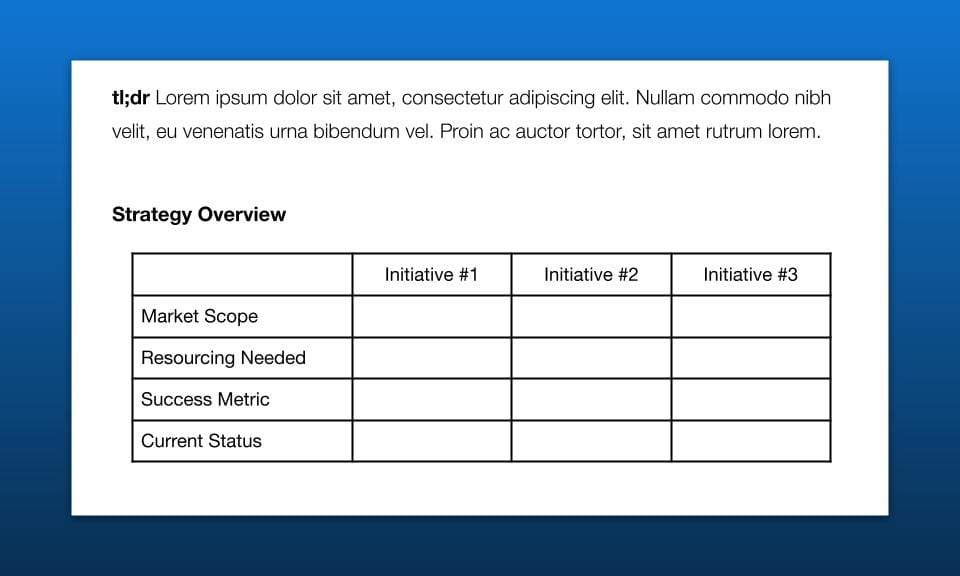
Again – there's no rocket science (in fact, the goal is probably to achieve the opposite). It's simply finding ways to lower comprehension tax for your audience.
#6 Signpost. A lot.
What is signposting? Wes Kao describes it perfectly in this fantastic post:
Signposting is using key words, phrases, or an overall structure in your writing to signal what the rest of your post is about. This helps your reader quickly get grounded, so their brain doesn’t waste cycles wondering where you’re taking them.
Instead of elaborating further here – I highly recommend reading her take on it.
Note also that signposting is important not only for writing – but also for when we speak. You can read my take on how to do it effectively.
#7 Demand precision.
Polished writing isn't fancy. It's just incredibly precise.
So don't say:
"This is a really interesting market with a lot of great potential."
Why? Because it's vague and unhelpful. Think about it – it could imply any one of the following statements:
"This is a fast-growing market that we've barely monetised (and we should devise a plan for it)."
"We see very unique consumer behaviors in this market; the learnings we uncover here have implications for our 5-year plan."
"This market won't be ready for monetisation in the short run, but we should start studying it already."
Of course, you don't have to nitpick every sentence. Nor is the goal to dummy-proof every sentence with qualifiers and modifiers (that goes against principle #3 and #4).
Rather, it's all about intentionality.
Because sometimes you want to be highly precise and leave no room for misinterpretation. While sometimes you want to trade away precision for crispness, and you know that's OK (because detail will ensue).
Either is fine – as long as there is a high degree of intentionality. Just don't let laziness get in the way.
👋 Subscribe for free to get Herng's newsletter directly in your inbox.
#8 Lead with the beef.
We talked about the importance of having a tl;dr up front. By the same token, you want to craft your sentences and paragraphs in a way such that the core concept tend to show up first.
You don't need to adhere to this religiously. But sometimes it makes a big difference. For example, consider the following paragraph:
Compared to last year – where we did not prioritize paid acquisitions – this year we prioritized digital advertising channels and cleaned up our data attribution. This led to 3x growth vs. last year at highly competitive ROI levels – truly incredible results.
This is not wrong, technically. Except half the people will probably read the first few words (and yawn) and skip ahead.
And how could you blame them? The key message (an exciting one at that) has been buried at the very end, and the reader was given no reason to read past the first few words.
Remember: attention and comprehension are earned, not given. The onus is on the writer to make it as easy (and as compelling) as possible for the reader.
So as an alternative, consider the following adjustment:
Our two key bets this year have delivered incredible results (new acquisitions are up 3x vs. last year): (a) Prioritizing digital advertising channels (b) Cleaning up data attribution.
You can also further tweak this to turn the spotlight onto the what ("acquisitions are up") instead of the how ("two key bets"), i.e. –
We tripled new acquisitions this year – all thanks to two key bets that panned out. The two bets: (a) Prioritizing digital advertising channels (b) Cleaning up data attribution.
It may seem like we're splitting hairs with these adjustments, but think of it as insurance. Again: attention is earned, not given. You do a huge disservice to your own hard work (and to the reader as well) by burying the lede.
Why take the risk?
#9 Write with an audience in mind.
There is no such thing as a perfect document. There is also no such thing as a perfect document for everyone.
And if you do not write with a specific audience in mind – your document will not work for anyone.
Before I write a document, I try to ask myself these questions:
- Who is my primary audience?
- How far will my document travel?
- How much context do I expect the reader to have?
- How high are the stakes? Does misinterpretation matter?
Why do these questions matter? Because then I'm able to decide:
- How much jargon can I use?
- How much detail should I go into?
- How much context do I need to provide?
- How much evidence do I need to land my point?
- What arguments do my readers care the most about?
As an example, let's say I'm a leader in the business org. I'm writing a proposal to ask a senior finance leader (who has little familiarity with my market) to invest in a new initiative.
Then I would consciously write in the following way:
- Limit my use of jargon or abbreviations
- Minimize unnecessary detail (but link out selectively in footnotes)
- Provide local market context (in order to properly educate)
- Surface evidence that is quantitative and robust
- Tie my arguments to financial outcomes
The best pieces of writing don't work for everybody. They're written in a way so that they're highly optimized for the primary reader.
And it's the writer's job to make those trade-off's.
